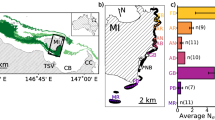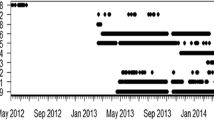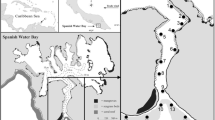Abstract
The medusae of cubozoan jellyfishes have sophisticated behaviours and are strong swimmers. Therefore, they have the potential to influence their distribution and connectivity among populations. We used ecological and behavioural data in combination with local oceanography to estimate the potential of medusae in the cubozoan Copula sivickisi to disperse from local populations at scales of hundreds of meters to kilometres. The distribution of C. sivickisi was mapped on a fringing reef at Magnetic Island, Queensland, Australia, with underwater jellyfish camera units (JCams). The availability of reef habitat, dominated by Sargassum sp. algae and coral, had a significant effect on the abundance of medusae. Medusae were 11–7 times more abundant at shallow (≤ 4.1 m) and mid-depth (4.2–7 m) sites with high to moderate habitat availability, compared to deep sites (≥ 7.1 m) where habitat availability was low. Further, medusae were absent at sites far from suitable habitat, both alongshore and in deeper waters. Medusae displayed preferential habitat selection. They were found low in the water column near reefs in depth stratified plankton tows and they preferentially attached to Sargassum in a habitat choice experiment. The swimming speeds of C. sivickisi medusae were determined experimentally and were equivalent to or faster than most of the current speeds measured where the populations occured. The results suggested that medusae can attach to habitat and swim against currents to maintain positions on reefs, thereby restricting dispersal. Incipient speciation is highly likely within the species’ cosmopolitan distribution.









Similar content being viewed by others
References
Acevedo MJ, Fuentes VL, Olariaga A, Canepa A, Belmar MB, Bordehore C, Calbet A (2013) Maintenance, feeding and growth of Carybdea marsupialis (Cnidaria: Cubozoa) in the laboratory. J Exp Mar Biol Ecol 439:84–91. https://doi.org/10.1016/j.jembe.2012.10.007
Acevedo MJ, Straehler-Pohl I, Morandini AC, Stampar SN, Bentlage B, Matsumoto GI, Yanagihara A, Toshino S, Bordehore C, Fuentes VL (2019) Revision of the genus Carybdea (Cnidaria: Cubozoa: Carybdeidae): clarifying the identity of its type species Carybdea marsupialis. Zootaxa 4543(4):515–548. https://doi.org/10.11646/zootaxa.4543.4.3
Andutta FP, Kingsford MJ, Wolanski E (2012) 'Sticky water' enables the retention of larvae in a reef mosaic. Estuar Coast Shelf Sci 101:54–63. https://doi.org/10.1016/j.ecss.2012.02.013
Baring RJ, Fairweather PG, Lester RE (2018) Nearshore drift dynamics of natural versus artificial seagrass wrack. Estuar Coast Shelf Sci 202:164–171. https://doi.org/10.1016/j.ecss.2017.12.017
Brett JR (1964) The respiratory metabolism and swimming performance of young sockeye salmon. J Fish Res Board Can 21:1183–1226
Buskey EJ (2003) Behavioral adaptations of the cubozoan medusa Tripedalia cystophora for feeding on copepod (Dioithona oculata) swarms. Mar Biol 142:225–232
Cappo M, Speare P, De'ath G (2004) Comparison of baited remote underwater video stations (BRUVS) and prawn (shrimp) trawls for assessments of fish biodiversity in inter-reefal areas of the Great Barrier Reef Marine Park. J Exp Mar Biol Ecol 302(2):123–152. https://doi.org/10.1016/j.jembe.2003.10.006
Chin A, Heupel MR, Simpfendorfer CA, Tobin AJ (2013) Ontogenetic movements of juvenile blacktip reef sharks: evidence of dispersal and connectivity between coastal habitats and coral reefs. Aquat Conserv 23(3):468–474. https://doi.org/10.1002/aqc.2349
Cochran WG (1954) Some methods for strengthening the common χ2 tests. Biometrics 10:417–451
Cohen J (1988) Statistical power analysis for the behavioral sciences. Routledge, New York. https://doi.org/10.4324/9780203771587
Colin SP, Costello JH, Katija K, Seymour J, Kiefer K (2013) Propulsion in cubomedusae: mechanisms and utility. PLoS ONE 8(2):12. https://doi.org/10.1371/journal.pone.0056393
Davies AM, Lawrence J (1994) Examining the influence of wind and wind-wave turbulence on tidal currents, using a 3-dimensional hydrodynamic model including wave-current interaction. J Phys Oceanogr 24(12):2441–2460. https://doi.org/10.1175/1520-0485(1994)024%3c2441:Etiowa%3e2.0.Co;2
Dawson MN (2005) Incipient speciation of Catostylus mosaicus (Scyphozoa, Rhizostomeae, Catostylidae), comparative phylogeography and biogeography in south-east Australia. J Biogeogr 32:515–533
Dawson MN, Hamner WM (2005) Rapid evolutionary radiation of marine zooplankton in peripheral environments. Proc Natl Acad Sci USA 102(26):9235–9240. https://doi.org/10.1073/pnas.0503635102
Dawson MN, Sen Gupta A, England MH (2005) Coupled biophysical global ocean model and molecular genetic analyses identify multiple introductions of cryptogenic species. Proc Natl Acad Sci USA 102(34):11968–11973. https://doi.org/10.1073/pnas.0503811102
Durlak JA (2009) How to select, calculate, and interpret effect sizes. J Pediatr Psychol 34(9):917–928. https://doi.org/10.1093/jpepsy/jsp004
Fossette S, Gleiss AC, Chalumeau J, Bastian T, Armstrong CD, Vandenabeele S, Karpytchev M, Hays GC (2015) Current-oriented swimming by jellyfish and its role in bloom maintenance. Curr Biol 25(3):342–347. https://doi.org/10.1016/j.cub.2014.11.050
Freiwald J (2012) Movement of adult temperate reef fishes off the west coast of North America. Can J Fish Aquat Sci 69(8):1362–1374. https://doi.org/10.1139/f2012-068
Garm A, Bielecki J (2008) Swim pacemakers in box jellyfish are modulated by the visual input. J Comp Physiol A 194:641–651
Garm A, O'Connor M, Parkefelt L, Nilsson DE (2007) Visually guided obstacle avoidance in the box jellyfish Tripedalia cystophora and Chiropsella bronzie. J Exp Biol 210:3616–3623
Garm A, Oskarsson M, Nilsson DE (2011) Box jellyfish use terrestrial visual cues for navigation. Curr Biol 21:798–803
Garm A, Bielecki J, Petie R, Nilsson DE (2012) Opposite patterns of diurnal activity in the box jellyfish Tripedalia cystophora and Copula sivickisi. Biol Bull 222(1):35–45
Garm A, Hedal I, Islin M, Gurska D (2013) Pattern- and contrast-dependent visual response in the box jellyfish Tripedalia cystophora. J Exp Biol 216(24):4520–4529. https://doi.org/10.1242/jeb.091934
Garm A, Bielecki J, Petie R, Nilsson DE (2016) Hunting in bioluminescent light: vision in the nocturnal box jellyfish Copula sivickisi. Front Physiol 7:9. https://doi.org/10.3389/fphys.2016.00099
Gemmell BJ, Costello JH, Colin SP, Stewart CJ, Dabiri JO, Tafti D, Priya S (2013) Passive energy recapture in jellyfish contributes to propulsive advantage over other metazoans. Proc Natl Acad Sci USA 110(44):17904–17909. https://doi.org/10.1073/pnas.1306983110
Gemmell BJ, Colin SP, Costello JH (2018) Widespread utilization of passive energy recapture in swimming medusae. J Exp Biol 221(1):5. https://doi.org/10.1242/jeb.168575
Hamner WM, Jones MS, Hamner PP (1995) Swimming, feeding, circulation and vision in the Australian box jellyfish, Chironex fleckeri (Cnidaria: Cubozoa). Mar Freshw Res 46(7):985–990. https://doi.org/10.1071/mf9950985
Hartwick RF (1991) Observations on the anatomy, behaviour, reproduction and life cycle of the cubozoan Carybdea sivickisi. Hydrobiologia 216(217):171–179
Hixon MA, Beets JP (1993) Predation, prey refuges, and the structure of coral-reef fish assemblages. Ecol Monogr 63(1):77–101. https://doi.org/10.2307/2937124
Kingsford MJ (1992) Drift algae and small fish in coastal waters of northeastern New Zealand. Mar Ecol Prog Ser 80(1):41–55. https://doi.org/10.3354/meps080041
Kingsford MJ (1993) Biotic and abiotic structure in the pelagic environment—importance to small fishes. Bull Mar Sci 53(2):393–415
Kingsford MJ, Choat JH (1985) The fauna associated with drift algae captured with a plankton-mesh purse seine net. Limnol Oceanogr 30(3):618–630. https://doi.org/10.4319/lo.1985.30.3.0618
Kingsford MJ, Battershill CN (eds) (1998) Studying temperate marine environments: a handbook for ecologists. University of Canterbury Press, Christchurch
Kingsford MJ, Mooney CJ (2014) The ecology of box jellyfishes (Cubozoa). In: Pitt KA, Lucas CH (eds) Jellyfish blooms. Springer, Dordrecht, pp 267–302
Lawley JW, Ames CL, Bentlage B, Yanagihara A, Goodwill R, Kayal E, Hurwitz K, Collins AG (2016) Box jellyfish Alatina alata has a circumtropical distribution. Biol Bull 231(2):152–169
Lewis C, Long TAF (2005) Courtship and reproduction in Carybdae sivickisi (Cnidaria: Cubozoa). Mar Biol 147:477–483
Lewis C, Kubota S, Migotto AE, Collins AG (2008) Sexually dimorphic cubomedusa Carybdea sivickisi (Cnidaria: Cubozoa) in Seto. Wakayama, Jpn. https://doi.org/10.5134/72820
Llewellyn LE, Bainbridge S, Page G, O'Callaghan MD, Kingsford MJ (2016) StingerCam: a tool for ecologists and stakeholders to detect the presence of venomous tropical jellyfish. Limnol Oceanogr Methods 14:649–657
Mantel N, Haenszel W (1959) Statistical aspects of the analysis of data from retrospective studies of disease. J Natl Cancer Inst 22:719–748
Matsumoto GI (1995) Observations on the anatomy and behaviour of the cubozoan Carybdea rastonii Haacke. Mar Freshw Behav Physiol 26(2–4):139–148
Matuschek H, Kliegl R, Vasishth S, Baayen H, Bates D (2017) Balancing type I error and power in linear mixed models. J Mem Lang 94:305–315. https://doi.org/10.1016/j.jml.2017.01.001
Mayr E (1954) Change of genetic environment and evolution. In: Huxley J, Hardy AC, Ford EB (eds) Evolution as a process. Allen and Unwin, London, pp 157–180
McDonald JH (2014) Handbook of biological statistics, 3rd edn. Sparky House Publishing, Baltimore
Mooney CJ, Kingsford MJ (2016) Discriminating populations of medusae (Chironex fleckeri, Cubozoa) using statolith microchemistry. Mar Freshw Res 68:1144–1152. https://doi.org/10.1071/MF16104
Mooney CJ, Kingsford MJ (2017) Statolith morphometrics as a tool to distinguish among populations of three cubozoan species. Hydrobiologia. https://doi.org/10.1007/s10750-016-2949-6
Nilsson DE, Gislen L, Coates MM, Skogh C, Garm A (2005) Advanced optics in a jellyfish eye. Nature 435:201–205
R Core Team (2017) R: a language and environment for statistical computing. R Foundation for Statistical Computing, Vienna
Schlaefer JA, Wolanski E, Kingsford MJ (2018) Swimming behaviour can maintain localised jellyfish (Chironex fleckeri: Cubozoa) populations. Mar Ecol Prog Ser 591:287–302. https://doi.org/10.3354/meps12305
Schroth W, Jarms G, Streit B, Schierwater B (2002) Speciation and phylogeography in the cosmopolitan marine moon jelly, Aurelia sp. BMC Evolut Biol 2(1):1. https://doi.org/10.1186/1471-2148-2-1
Shorten M, Davenport J, Seymour JE, Cross MC, Carrette TJ, Woodward G, Cross TE (2005) Kinematic analysis of swimming in Australian box jellyfish, Chiropsalmus sp and Chironex fleckeri (Cubozoa, Cnidaria: Chirodropidae). J Zool 267:371–380. https://doi.org/10.1017/s0952836905007600
Sinclair M (1988) Marine populations: An essay on population regulation and speciation. University of Washington Press, Seattle, WA, p 260
Stewart SE (1996) Field behavior of Tripedalia cystophora (class Cubozoa). Mar Freshw Behav Physiol 27(2–3):175–188
Stobutzki IC, Bellwood DR (1994) An analysis of the sustained swimming abilities of presettlement and postsettlement coral-reef fishes. J Exp Mar Biol Ecol 175(2):275–286. https://doi.org/10.1016/0022-0981(94)90031-0
Werner B, Cutress CE, Studebaker JP (1971) Life cycle of Tripedalia cystophora conant (Cubomedusae). Nature 232(5312):582–583. https://doi.org/10.1038/232582a0
Williamson DH, Harrison HB, Almany GR, Berumen ML, Bode M, Bonin MC, Choukroun S, Doherty PJ, Frisch AJ, Saenz-Agudelo P, Jones GP (2016) Large-scale, multidirectional larval connectivity among coral reef fish populations in the Great Barrier Reef Marine Park. Mol Ecol 25(24):6039–6054. https://doi.org/10.1111/mec.13908
Wolanski E (2017) Bounded and unbounded boundaries - Untangling mechanisms for estuarine-marine ecological connectivity: scales of m to 10,000 km—a review. Estuar Coast Shelf Sci 198:378–392. https://doi.org/10.1016/j.ecss.2016.06.022
Acknowledgements
The authors would like to thank Mark O’Callaghan for his great help with the field work. Figures 2 and 3 contain symbols from the Integration & Application Network Symbol Libraries (https://ian.umces.edu/symbols/) authored by Tracey Saxby and Diana Kleine. We thank the Australian Research Council, Centre of Excellence for Coral Reef Studies and James Cook University for their financial support. Finally, we thank the anonymous reviewers who took the time to provide valuable feedback on the manuscript.
Funding
This research was supported by funding from the Australian Research Council, Centre of Excellence for Coral Reef Studies awarded to Michael Kingsford and funding from James Cook University, College of Science and Engineering provided to Jodie Schlaefer.
Author information
Authors and Affiliations
Corresponding author
Ethics declarations
Conflict of interest
The authors have no conflict of interest. All data from this research are available on request.
Ethical approval
This research was conducted in accordance with James Cook University’s Animal Ethics Committee’s policies, procedures and guidelines. No specific permissions were required.
Additional information
Responsible Editor: X. Irigoien.
Publisher's Note
Springer Nature remains neutral with regard to jurisdictional claims in published maps and institutional affiliations.
Reviewed by undisclosed experts.
Electronic supplementary material
Below is the link to the electronic supplementary material.
Supplementary file2 (MP4 4,665 kb)
Supplementary file3 (MP4 16,713 kb)
Supplementary file4 (MP4 3,832 kb)
Supplementary file5 (MP4 11,698 kb)
Supplementary file6 (MP4 29,959 kb)
Supplementary file7 (MP4 16,943 kb)
Rights and permissions
About this article
Cite this article
Schlaefer, J.A., Wolanski, E., Yadav, S. et al. Behavioural maintenance of highly localised jellyfish (Copula sivickisi, class Cubozoa) populations. Mar Biol 167, 40 (2020). https://doi.org/10.1007/s00227-020-3646-6
Received:
Accepted:
Published:
DOI: https://doi.org/10.1007/s00227-020-3646-6




